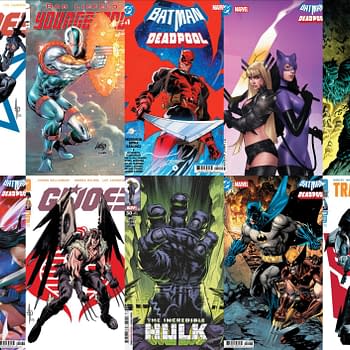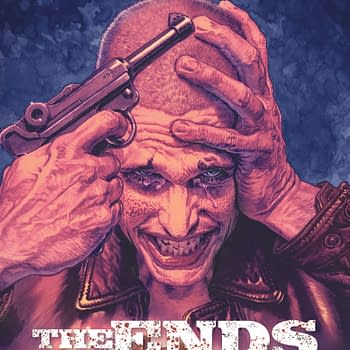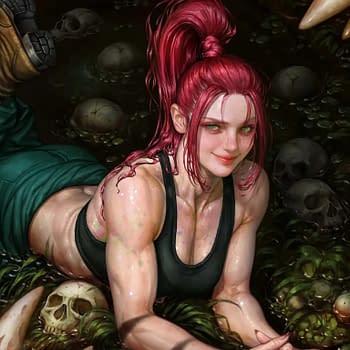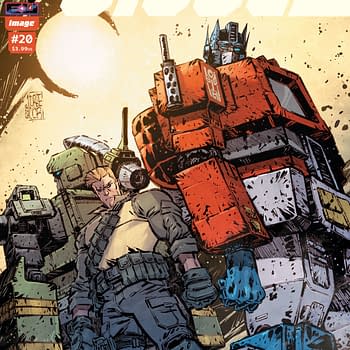Posted in: Comics | Tagged: Batman, dc, dc comics, entertainment, grant morrison, Robin Rises, Robin Rises: Omega
How Robin Rises Did Away With Grant Morrison's Batman
Mark Bristow writes,
With the preview and publishing of Robin Rises: Omega, we're left with some awesome revelations and also many questions.
Robin Rises is a direct continuation of Grant Morrison's huge Batman epic.
For long-term fans that have followed Morrison's run from the start, or at least before the Flashpoint event, we've had questions about what really happened in Batman's recent past.
The New 52 was never shy about repeating lines about Batman's recent death and Dick Grayson's time spent as Batman. It's been repeated throughout several titles in the Batman family of books, recently and further back near the start of the New 52. But, with Final Crisis as a line-wide event no longer in continuity, we didn't know how it all went down.
Did some other event take out Bruce Wayne, sending him through time? Did he really have that stand-off with Darkseid? If so, was it during Final Crisis or some other context? We've been without a clear answer for three years, some theorizing that one of Cyborg's accidental teleports to Apokolips (As revealed in Justice League #8 by Geoff Johns) possibly set the scene for Batman's showdown with Darkseid, as the current stories have stressed that Darkseid has NOT returned to earth since his initial encounter with the League five years ago.
Robin Rises begins with a pages-long summary of Batman's history as it pertains to Damian's life. It features a streamlined version of his affair with Talia, his first encounter with her father, Ra's Al Ghul, and Bruce's eventual demise at the hands of Darkseid and his trip through time in Return of Bruce Wayne. These panels are all drawn in detail, making direct references to the originals as they were printed back then.
These are all familiar events to readers, but the main problem starts when Bruce is face-to-face with Glorious Godfrey, Darkseid's personal evangelist. The dialogue suggests that Batman's only time having faced Darkseid was five years ago, during the formation of the New 52 incarnation of the Justice League. This is mainline New 52 continuity, as established many times over in the last three years.
Bruce's demise at the hands of Darkseid is roughly one year ago in the current timeline, falling immediately after he first met Damian and the events of RIP, which are still fully in continuity.
DC is no stranger to post-Crisis effects, which some would describe as a sort of post-event fatique. It's when the DC publishing narrative attempts to recover from the universe-shattering premise of a Crisis. What's left in history? What's changed? Who remembers it? We usually see DC scramble to organize these characters and mostly have them shrug off the huge consequences of what they've just endured for the sake of continued publishing.
There are always anomolies. Certain characters will continue onward and represent what that Crisis event accomplished while much of the main DC line trends towards ignoring it.
Barry Allen, for instance.
Flashpoint's sort of affect on DC history is nothing new. The first Crisis on Infinite Earths resulted in the birth of a new singular world, a world where Infinite Earths never existed. This is a strong restarting point, but the problem was that DC didn't fully reboot their line back then either, instead relying on half-truths and pick-and-choose storytelling. Sound familiar? The post-Crisis DCU now existed in a reality where Barry Allen of Earth 1 was accounted-for dead on a world where New Earth was the only history to have ever existed. Earth 1 had never existed, yet Barry still did, and died before the actual birth of New Earth.
Who was this Barry that everyone remembered? How did he differ from the Earth 1 incarnation? What was everyone's recollection of his life and death? We wouldn't get an answer to these questions until 2010's Flash Rebirth, almost 30 years later, an event that would cement the backstory of the post-Crisis Barry Allen in ways that would influence the character for years, even entering into the story of the CW Flash tv show.
For all intents, Bruce Wayne's death and return continue as a sort of anomoly of a Crisis, much like Barry Allen was. The whole universe had changed, but Barry's death had not, even when the event that led to his death could no longer be a solid part of their current continuity. This is the exact same situation in which Batman currently exists in regards to his death in Final Crisis. The full story belongs to some forgotten echo of the editing universe, evidenced only by the continued existence of the character affected.
Intriguing but troubling to devotees of Morrison's story are the implications of Batman now returning to Apokolips to resolve his son's death. Batman's narrative under Morrison was that the character was involved with and witnessed the END of the Fourth World and those Gods. Batman overcoming and moving beyond that huge event was a centerpiece of Morrison's self-fulfilling Batman prophecy.
It is odd to see the world's greatest detective competely fail to draw a connection between the Evil Gods kidnapping his son's body and the Evil Gods that took his life only a year ago. The editorial influence is almost suffocating.
Most readers try not to put such a huge bounty on the continuity of these characters. For those of us who devoted years to Morrison's story, we can only look to the value of history, as the entire premise for his Batman story was to surround the character with history and bring it further in, not throw it away. To add and enrich, not subtract and reduce.
For the rest of us, the hopelessly tragic readers who feed desperately on every scrap of history we can cling to, I only hope this major continuity problem is resolved by story's end.
History suggests otherwise, even if it isn't reliable anymore.














